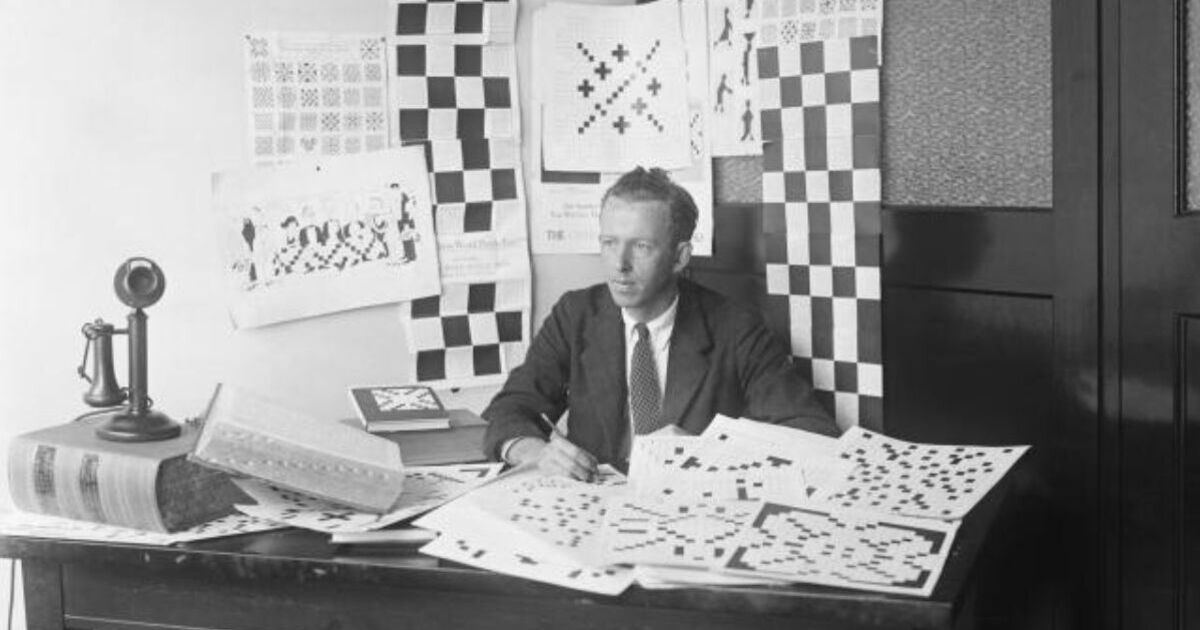One hundred years ago this week the Sunday Express published the first crossword in a British newspaper. Since then, general knowledge and cryptic versions have become a daily ritual for millions, exercising mind, memory and logic.
The hit composer Stephen Sondheim said: “The nice thing about doing a crossword is you know there is a solution.”
But they were a long time coming. The fascination with word patterns goes back to the ancient empires of Rome, Greece, Egypt and Syria, with examples of word squares scratched on to the walls of villas and barracks.
During the growth of the leisured classes in the 19th century, puzzles incorporating words in intricate designs became popular.
But it took a Liverpudlian to come up with the first modern crossword.
Arthur Wynne, the son of the editor of the local Liverpool Mercury, had emigrated to America aged 19 and by 1913 was editing a weekly puzzle page for the comic section of the New York World.
For the Christmas edition, Wynne wanted something new and from his New Jersey home created a diamond-shaped grid built around a central framework of two horizontal and two vertical lines of seven squares.
Words ran either horizontally or vertically, and the reader had to “fill in the small squares which agree to the following definitions” in what Wynne called a Word-Cross Puzzle.
The first and last squares of each word were numbered as was the clue to which the answer related. To kicks things off, Wynne filled the top horizontal with “Fun”.
The puzzle proved popular and was printed weekly. A typographical error transposed its title to cross-word and that stuck.
Wynne also experimented with the shape of the grid before settling on the now familiar rectangle with shaded squares used to separate the words or phrases.
Crossword mania swept America in the early 1920s, giving commuters on the new Metro lines something to occupy their minds.
New York Public Library complained that “puzzle fans swarm to the dictionaries and encyclopaedias so as to drive away readers and students who need these books in their daily work”.
The New York Times hit out at the “sinful waste in the utterly futile finding of words the letters of which will fit into a prearranged pattern, more or less complex. This is not a game at all, and it hardly can be called a sport … Solvers get nothing out of it except a primitive form of mental exercise, and success or failure in any given attempt is equally irrelevant to mental development.”
It added: “Fortunately, the question of whether the puzzles are beneficial or harmful is in no urgent need of an answer. The craze evidently is dying out fast and in a few months it will be forgotten.”
A clergyman called them “the mark of a childish mentality” and said, “there is no use for persons to pretend that working one of the puzzles carries any intellectual value with it.” Such criticism was ignored.
The US phenomenon was initially disdained in Britain. The Times newspaper ran an editorial headlined ‘An Enslaved Nation’.
But despite such scorn, Britain’s reading public demanded something similar. And in 1922 Pearson’s Magazine published the first crossword this side of the Atlantic. The Sunday Express became the first British newspaper to print one on November 2, 1924, adapting a Wynne puzzle for UK readers and cutting out American slang. Ten prizes of £1 1s were up for grabs for the first 10 correct postal solutions opened by the paper.
Others newspapers followed and in February 1930, even The Times deigned to publish one.
The first cryptic crossword was in the Daily Telegraph in July 1925, and by the 1930s clues were much more sophisticated, containing full or partial anagrams, double meanings and themes.
Some cryptologists hired as codebreakers in the wartime Bletchley Park were selected after doing well in a national crossword-solving competition.
In May 1944, an Observer crossword compiled by headmaster Leonard Dawe contained words associated with the D-Day preparations, such as Omaha, Utah, Neptune and Overlord. Intelligence officers found nothing linking Dawe to Germany. The enigma was put down to coincidence.
Forty years later it emerged that a group of pupils who helped Dawe to compile his puzzles brought back gossip they had picked up from nearby barracks. Dawe was mortified.
Meanwhile, Wynne died in Florida in 1945 aged 71. By then crosswords were a feature in virtually every newspaper across the Western world.
Strangely, it was not until 1968 that a cryptic crossword made its way to America. Thanks to the efforts of US composer Stephen Sondheim, a fan of British crosswords, one was first published in the New Yorker magazine. But Americans never embraced cryptics as much as the British.
The Guinness Book of Records lists Roger Squires of Ironbridge, Shropshire, as the most prolific crossword compiler – in May, 2007 he published his 66,666th crossword, equivalent to over two million clues.
Some of the best Cryptic Clues:
London flower (6 letters) – Thames
Bar of soap (6.6 letters) – Rovers Return
Gegs (9, 4 letters) – Scrambled eggs
014 (6,5 letters) – Double agent
(8 letters) – Clueless
Checkout latest world news below links :
World News || Latest News || U.S. News
The post How Arthur Wynne’s puzzle sparked a century-long crossword craze appeared first on WorldNewsEra.

